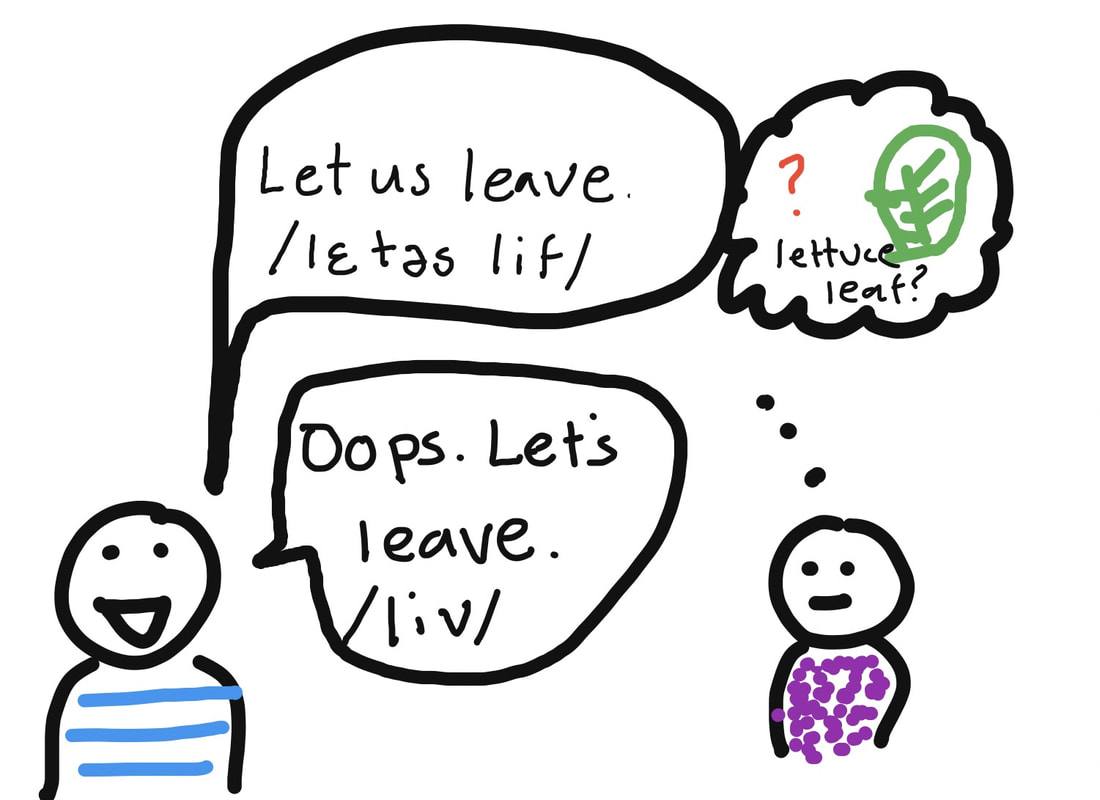|
Do people often ask you to repeat yourself? Do you sometimes notice a look of confusion on your listener's face, but they don't tell you that they haven't understood you? These can be frustrating situations as a speaker. One of the biggest advantages of the S.M.A.R.T. method of American Accent training is giving you the knowledge you need to understand why the communication breakdown happened. Not only does the training help reduced these embarrassing and frustrating encounters, but also when they do happen, you'll know what went wrong and how to clarify what you've said. Our new video series is all about the words that are frequently misunderstood or mispronounced, and how to correct them. You can check it out here. Like this video? Why not get a free trial of our online courses? Sign up today.
0 Comments
Check out our "Real Talk" series: compare spoken and written English to improve your natural, fluent American Accent. Check out the full playlist here: Real Talk Series
Do you have a goal you are currently working on? My current personal goal is to sing a solo with my choir. Working as an American Accent coach, I've learned a lot about setting goals and what makes people achieve them or abandon them. It often comes down to a few simple things. 1) Set a small, achievable goal. Maybe you want to be the CEO of a major corporation. Maybe you want to be indistinguishable from a native English speaker. Maybe you want to be as thin as a model. These are fine goals, but they require a great deal of time and and effort. Focus first on the steps you need to reach this end goal - getting a promotion to team leader, changing one accent pattern in your speech, or losing 2 pounds. By setting a small goal, you greatly increase your chances of achieving it, and staying on the path to your bigger goal. My first step to singing a solo is to audition for one. I may not get it this time, but I will be happy if I have the courage to try out. 
2) Make it a habit. We humans are creatures of habit, and sometimes we have a hard time changing. Instead of fighting this about yourself, use it to your advantage. Take your small goal and develop a new habit that will help you progress towards the goal. Find a way to fold it into your routine and you will be much more likely to do it. For working on your accent, this could be something as simple as listening to your practice words for the first five minutes of your daily commute, or reading aloud for the first page of your usual reading in bed routine.
To reach my goal of auditioning for a solo with my choir, I am listening to recordings of my rehearsals when I go out for a walk. If I don't have time to practice, I can listen and work on the music as part of my already-established routine. 
3) Take advantage of low-tech and high-tech tools. Keeping your goal fresh in your mind is essential to achieving it. It's easy to let time go by without working towards our goal. Use a variety of reminders to stay on track. Put your practice time in your calendar. Even if you don't do it at that exact time, you'll be reminded that you want to work on it. Set an alert or an alarm on your phone. Put a sticky note on your computer, or phone, or tv that has your goal on it. Be creative, the important thing is to use what works for you.
I put my choir folder near the entrance to my office so I see it as I walk into work. This reminds me to look at my schedule and find a time to practice. I also set a reminder on my phone and I leave it on my pop-up screen until I have completed it.
4) Tell people your goal. If you know that other people know what you hope to achieve, you may feel more pressure to actually do it. Post your goal and your progress on your social media. Tell your friends or colleagues what you are trying to do, and enlist them for reminders and feedback. A little bit of social pressure can be motivating, and having support for your successes can inspire you to continue to work hard.
I will tell my friends in my choir about my goal so when it comes time to audition, I will know that they are expecting me to take part. I will tell me daughter that I have this goal and she will encourage me, and ask me if I have done it yet. These are all small things, but put together they will be effective in helping you to make real progress towards achieving your goal. You're talking to your colleague, boss, or team member at work, and you notice that they don't seem to get what you're saying. It might be your accent, but more times than not it is the way you are communicating. Navigating the maze of professional and social communication interactions can be confusing for the non-native English speaker, and even just for those whose strengths lie more in their technical expertise than their people skills. Here are five common mistakes you can fix to improve your success in communication. NUMBER ONE: EASE IN For most interactions, it's not best practice to start the interaction with the main purpose. Rather than telling someone to do something directly, for example, make sure you start with a greeting, compliment, or social question. Your colleague or team member will be more willing and ready to complete the task you are asking them to do if you've had a social exchange first. Even a short hello will smooth the way for your listener to engage with you. Example: You need your team member to give you some completed work. The Error: "Get me the numbers for last quarter." The Fix: "Hi Jim, do you have last quarter's numbers ready for me?" NUMBER TWO: GET TO THE POINT While it’s good to ease in, you also need to be cautious to not take up too much time. If your communication partner wants to have a longer conversation, great, but if you are the only one talking and you could share the same information in one sentence rather than 5, keep it simple. People are busy and don’t want to feel trapped having to politely listen while you lecture. Watch for body language cues (lack of eye contact, crossing arms or turning away) that show your listener would rather move on. Example: You want to tell someone about something you learned. The Error: "Susan, I found a great website. I was looking for an analysis tool for our analytics team to use in conjunction with the current tools and so first I . . . " (ten minutes later, still talking about details of this topic) The Fix: "Hi Susan, how are you? Can I tell you about a website I found that I think you'll find useful? It's an analysis tool - I can send you the link and if you'd like to talk about it more, we could meet for coffee and look at it together." NUMBER THREE: WATCH YOUR RATE In some cultures (including some American subcultures), a fast speaking rate is associated with intelligence. People will speak very quickly and with very few pauses in order to seem knowledgeable or show their expertise on a topic. While a fast rate is not necessarily a problem, if you have speech that is more difficult to understand due to your accent, your word choice or another reason, speaking too quickly can compound the issue. In addition, a lack of pauses can make it difficult for your listener to process all of the information, ask questions or comment and participate in the conversation. Example: You want to teach your team member a better way to do something. The Error: "You need to use a different browser because the one you're using doesn't load as quickly and tends to crash for websites that use Flash, which is a headache by the way because it always needs to update and most people don't keep their updates current for their PC's . . . (continues without pausing)" The Fix: "Hey Amir, I see you're using Safari. Is that your default browser?" pause and wait for response, continue. "Can I show you a better option?" NUMBER FOUR: WHAT IS YOUR BODY LANGUAGE SAYING? Different cultures use different body language to show interest, respect, or give feedback cues. You may be sending a different message than you intend to depending on your body language, or you may be revealing your true attitude when you'd rather keep it to yourself. Understanding body language is key to appropriate interactions, both as the speaker and the listener. Read More About Body Language Here NUMBER FIVE: USE REPAIR STRATEGIES
Even the best communicators can have misunderstandings occur. Sometimes, your listener simply wasn't paying attention and missed what you said. Maybe you used a word or expression they didn't know, or maybe they didn't know what topic you were on and the missed some key information. Whatever the reason, knowing how to identify and repair communication breakdowns is an important skill for any good communicator. Watch for cues that your listener didn't get it (facial expression, body language, off-topic or incorrect response). Don't simply repeat yourself, try re-phrasing, asking a clarifying question, or asking your listener to tell you paraphrase what you've said to make sure the message was clear. Example: You want someone to call you back on your mobile phone. The Error: "Call me back on my mobile, you have that number right?" (no response, or confused response) The Fix: "Oh, I think I wasn't clear. Can I give you my cell phone number to call me back? Can you tell me the number to make sure we have the correct information?" Being proactive as a communicator and looking for ways to be culturally and socially appropriate in your business and social interactions will make you more successful in getting what you need with your colleagues, team member and employers. Good communication opens doors in your career and improves your professional social life. Rather than feeling frustrated by your interactions, take a look at what you can do on your end to improve your communication skills. |
Subscribe to this blog:
Categories
All
Archives
March 2021
Copyright 2020
Christine Dunbar Have Questions?
Get A Free Consultation We offer a free 30-minute phone consultation. Schedule yours now. |






 RSS Feed
RSS Feed



